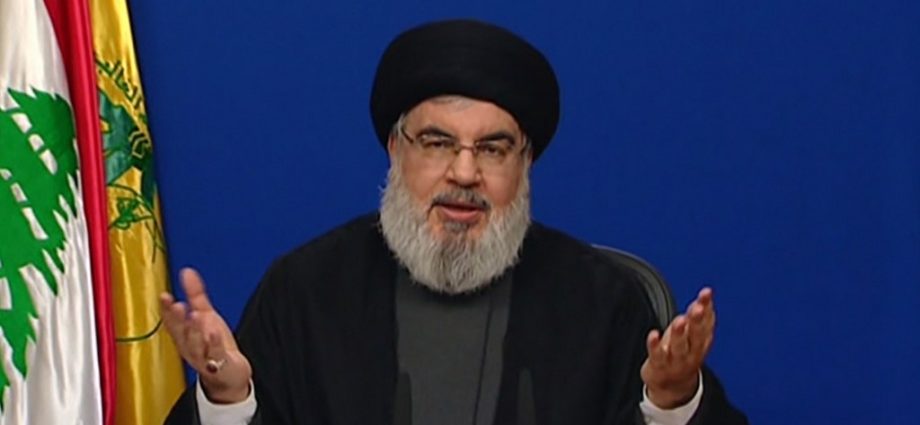
Nearly 20 years after its war with Israel, Hezbollah, with its persistent harassment of the Jewish state across Lebanon’s southern border, seems to be itching for a rematch. Why the militia is dragging a failing country to war is anyone’s guess.
In recent weeks, Hezbollah chief Hassan Nasrallah has renewed discussion of the 2006 war’s unfinished business. That conflict ended with the status of 13 border points unsettled, along with the fate of Shebaa Farms, a small strip of disputed land near the Golan Heights.
In the latter’s case, ownership should have been negotiated a month after the war, per UN Security Council Resolution 1701. But that never happened.
Nasrallah has justified his newfound urgency by saying that a year ago, Israel began constructing a fortified border wall to replace the flimsy barbed wire.
He added that Hezbollah isn’t seeking the demarcation of the land border between Israel and Lebanon, a process he rejected last October when the two sides set their maritime borders. Rather, he wants Israel to withdraw from every territory that Lebanon claims, without negotiations.
Why is Nasrallah trying to shake up the border now?
One theory is that he’s trying to renegotiate the rules of engagement with Israel, currently set at near-zero tolerance toward any cross-border attacks. Another suggests that Nasrallah wants to deflect Lebanese attention away from domestic misery in a country where the economy has been in free fall for years.
To spite Israel, Hezbollah erected tents on Shebaa Farms. Israel then lobbied world capitals to persuade the militia to remove them. If Hezbollah refuses, it’s not clear how far the Israeli government is willing to go to force the issue.
If border clashes escalate, Nasrallah said he’s confident of yet another victory – like the one he imagined in 2006 and the one that Hamas claimed in 2021.
Backing by Iran
Nasrallah insists that not only is his militia better armed and stronger than before, it would also be supported by pro-Iran militias like Hamas, Palestinian Islamic Jihad, and Iraqi Popular Mobilization Units that would “unify the fronts” and wage war on Israel simultaneously. But even then, it isn’t clear how Nasrallah can overpower Israel and force it to concede on any issue.
In the event of full-scale war, Hezbollah and Hamas would likely fire an unprecedented number of rockets in a bid to overwhelm Israel’s Iron Dome, hoping that some rockets sneak through.
Iran has supplied Hezbollah with explosive drones and precision-guided missiles (PGMs). As Iron Dome gets jammed, Hezbollah would then use its bigger rockets to strike strategic Israeli assets – such as Ben Gurion Airport, oil installations, chemical plants, and densely populated areas.
The Israeli Air Force (IAF) would be busy preempting or retaliating against the militias’ launchpads.
It’s possible that both Hezbollah and Hamas have dug tunnels that can transport their fighters behind Israeli lines. Such tunnels aren’t as dangerous as they sound because they are bottlenecks that force fighters to trickle into Israel, and only with light arms.
Tunnels wouldn’t enable the massing of Hezbollah or Hamas fighters or the shuttling of heavy arms needed to battle effectively with Israel Defense Forces (IDF). Still, militants behind Israeli lines could take hostages or briefly control a town, either of which would be an enormous publicity victory.
If Hezbollah or Hamas decided to walk into Israeli territory, Israel’s undisputed control of airspace would decimate the invading fighters. That was the main reason Israel reversed its fortunes against Egypt and Syria in 1973. When Egyptian ground troops exited their surface-to-air missile umbrella, the IAF took them out, clearing the way for a counterattack.
Nasrallah’s continuous bragging of how the days of humiliation are gone gives the impression that Iran and its militias have attained unprecedented power. But Israeli firepower dwarfs that of Iran and its militias combined. Israel enjoys a qualitative military edge over Iran that is bigger today than it was between Israel, on one hand, and Egypt and Syria, on the other, in 1967 and 1973.
Consider that in the 1967 war, when Arab armies suffered their worst defeat, they still managed to kill close to 800 Israeli troops, down 32 fighter jets, and destroy 400 tanks. Today, Iran and its militias don’t have the capacity to inflict a fraction of such losses on Israel.
This means that while Hezbollah and Hamas can disrupt Israeli life and give the Jewish state a bloody nose, they cannot cause enough Israeli alarm to call for general mobilization. As long as that’s the case, wars that Iranian militias launch on the Jewish state will remain border skirmishes, with militias inflicting minor damage on Israel and Israel responding with devastating force.
In 2006, Israel razed large swaths of Lebanon and its infrastructure. Had it not been for Arab states’ largesse that funded reconstruction, parts of Lebanon would still be under rubble.
This time, if Nasrallah drags Lebanon into another war with Israel, wealthy Arab countries will be loath to bail it out. Lebanon will just die, and maybe Gaza, too.
This article was provided by Syndication Bureau, which holds copyright.

